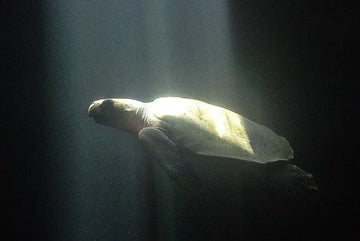The Olive Ridley sea turtle (Lepidochelys olivacea), also known as the Kemp's ridley sea turtle, is a small marine turtle with an average adult shell length ranging between 60 and 70 cm. To distinguish it from other sea turtles, one should observe its heart-shaped and dorsally flattened shell, which is higher in the anterior region towards the head, and its short snout.
Did you know that we have a collection of turtle T-shirts and sweatshirts? Among them is this green turtle, perfect as a gift!
The color of the Olive Ridley turtle's shell is greenish-gray and sometimes takes on reddish hues due to algae growth. The hatchlings are dark gray with a thin white line bordering the shell. Olive Ridley turtles rarely weigh more than 50 kg, and females are considerably larger than males.
Distribution of the Olive Ridley Turtle
 Distribution of the Olive Ridley Turtle, red circles indicate major nesting sites. Source Wikipedia
Distribution of the Olive Ridley Turtle, red circles indicate major nesting sites. Source WikipediaThe Olive Ridley turtle is considered the most abundant of sea turtles. However, they are in a vulnerable situation due to the scarcity of nesting sites worldwide, with their population having drastically reduced by up to 30% in the last 20 years. The Olive Ridley lives in tropical and warm waters in the Pacific and Indian Oceans, but they can also be found in the Atlantic Ocean, off the west coast of Africa, and the coasts of northern Brazil. Occasionally, they inhabit waters in the Caribbean and even the eastern Pacific Ocean, mainly in the Galápagos Islands.
Olive Ridley turtles usually inhabit shallow waters, between 22 and 50 meters near the coast, although these parameters change according to the turtles' age.
Nesting
Olive Ridley turtles are known for their synchronized nesting in groups of thousands in a few days, similar to what Kempii turtles do. In the Indian Ocean, most turtles nest in two or three large groups near Odisha, in the Bay of Bengal, India. In 1991, over 600,000 turtles nested along the coast of Odisha in a single week. Other important nesting sites for Olive Ridley turtles are in Mexico and Costa Rica.
Feeding of the Olive Ridley Turtle
The Olive Ridley turtle is carnivorous, primarily feeding on jellyfish, tunicates, sea urchins, shrimps, crabs, or lobsters. In their adult stage, they may also feed on fish.
Threats
Deterioration of their nesting sites and construction on those beaches are endangering the species. The synchronized nesting behavior requires large beaches, and the loss of nesting sites is negatively affecting the species. Some females, with limited space, unearth eggs previously laid by another turtle, hindering the proper incubation of those eggs. Another threat is pollution in the feeding areas of the Olive Ridley turtle, such as southern California, contaminated by wastewater, pesticides, and industrial discharges.
Like other sea turtle species, Olive Ridley turtle eggs have many predators such as raccoons, coyotes, dogs, or wild pigs, as well as hatchlings when they hatch on their way to the ocean: vultures, crabs, iguanas, and snakes hunt the hatchlings soon after birth. Adults have few predators except for the largest sharks or orcas, and attacks are sporadic.

Olive Ridley turtle hatchling after hatching. Image by jurvetson
Humans are the main threat to the Olive Ridley turtle, both through unsustainable egg collection and the hunting of females for the sale of their meat. Other significant threats include collisions with boats and accidental captures in trawl nets, longlines, and traps. In addition, there is the ingestion of marine debris such as plastics.





















